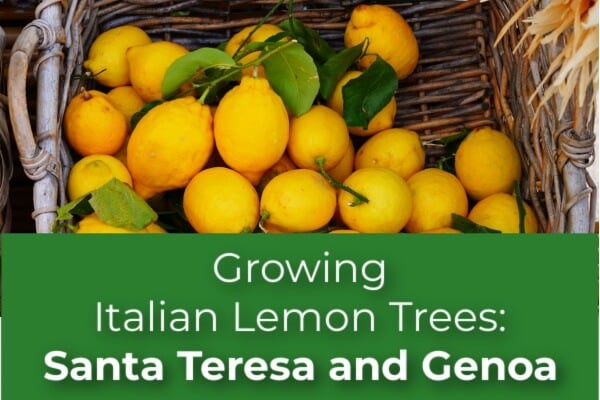Grow Citrus from Around the World
Citrus trees, with their vibrant fruits and aromatic blossoms, are a beauty unrivaled in the garden. Their diverse and exotic origins and unique characteristics make them sources for joy for citrus growers. Here are 14 extraordinary citrus varieties from different corners of the globe, with insights into their origins, characteristics, and flavors. Get inspired to bring these international treasures into your backyard. Maybe then you too will want to grow citrus from around the world!
1. Buddha's Hand Citron
Origin: Southeast Asia
Characteristics: If you want to grow citrus from around the world, why not start with Asia? The Buddha's Hand Citron, originally from China, is one of the most visually striking citrus fruits. Resembling a hand with outstretched fingers, this citron lacks pulp and juice, which is unique among citrus varieties. The fruit’s thick rind is intensely aromatic, with a long-lasting lemony fragrance.
Flavor: While it’s not typically consumed like other citrus fruits, Buddha's Hand is prized for its zest, which is used to flavor dishes, infuse spirits, and even perfume rooms. The zest has a sweet, floral taste with a hint of bitterness.
Buddha's Hand Semi-Dwarf Citron Tree

$65.00
--OVERVIEW-- Now available! 36"-48" Premium Buddha's Hand Semi-Dwarf Citron Trees Buddha's Hand got its name because its fruit forms finger-like sections resembling a human hand. Buddha's Hand Citron is much esteemed for its delicate lemon fragrance in China and Japan.… read more
2. Assad's Citron
Origin: Middle East
Characteristics: Assad's Citron is a rare variety known for its large size and thick rind. It is often used in religious rituals and traditional medicine in its native region. The fruit is bright yellow when ripe and has a highly fragrant peel.
Flavor: Like other citrons, Assad’s Citron is not typically eaten fresh due to its dry pulp. Instead, it is valued for its aromatic zest and peel, which can be candied or used in culinary preparations.
Assads Citron Bush

$32.00
--OVERVIEW-- Also known as Etrog/Ethrog or Moroccan citron, Assads Citron is a thick-peeled, fragrant lemon-like fruit is used for the Jewish autumn harvest festival and Feast of the Tabernacles, Sukkot. The "mother tree" of Assads was started from seed provided… read more
3. Makrut Lime (Citrus hystrix)
Origin: Southeast Asia
Characteristics: Makrut Lime, also known as Thai Lime, is a small, bumpy green fruit. The tree is notable for its glossy, double-lobed leaves, which are widely used in Southeast Asian cuisine. The fruit itself is quite sour and contains very little juice.
Flavor: The leaves are the true stars of the Makrut Lime, imparting a distinct, floral-citrus flavor to Thai curries, soups, and salads. The zest is also used in cooking, while the juice, though limited, is exceptionally tart.
Makrut (Kieffer/Kaffir) Thai Semi-Dwarf Lime Tree

$65.00
--OVERVIEW-- There has been some controversy surrounding one of the names of the Makrut lime, Kaffir, as it has derogatory connotations in South African and Middle Eastern cultures, which is why we prefer to simply call them Thai limes.… read more
4. Santa Teresa Lemon
Origin: Italy
Characteristics: The Santa Teresa Lemon is a renowned Italian variety known for its robust size and high juice content. It has a bright yellow skin and a pleasant aroma. This variety is often grown in the Amalfi Coast region, celebrated for producing some of the world’s finest lemons.
Flavor: Santa Teresa Lemons are highly prized for their rich, tangy flavor and are a staple in Mediterranean cuisine. They are ideal for making limoncello, a popular Italian liqueur, as well as for culinary uses in both sweet and savory dishes.
Santa Teresa Femminello Semi-Dwarf Lemon Tree

$65.00
--OVERVIEW-- Now Available in the 36"-48" Premium Size! The Santa Teresa lemon tree is a highly productive variety which grows medium sized lemons with a high acid content. Feminello selections account for nearly 75% of the Italian lemon crop each… read more
5. Calamansi
Origin: Philippines
Characteristics: Calamansi, also known as Calamondin, is a small, round citrus fruit that resembles a miniature orange. The tree is compact, making it perfect for container gardening. The fruit has a thin, smooth skin that turns from green to orange as it ripens.
Flavor: Calamansi combines the flavors of lime and mandarin orange, offering a unique sweet-tart taste. It is commonly used in Filipino cuisine to flavor sauces, marinades, and beverages. The juice is also popular in refreshing drinks and desserts.
Calamondin/ Calamansi Semi-Dwarf Tree

$65.00
--OVERVIEW-- Now Available! 36"-48" Calamondin Semi-Dwarf Trees The Calamondin citrus fruit, also called Calamansi, is prized in the Philippines. This variety has prolific fruit production. Its small sour orange fruit used as you would use a lime. Calamondin trees have… read more
6. Yuzu
Origin: Japan
Characteristics: Yuzu is a small, yellow-green citrus fruit with a bumpy rind. It is highly aromatic and contains numerous seeds. Yuzu trees are hardy and can withstand colder temperatures compared to other citrus varieties.
Flavor: Yuzu’s tart flavor is a complex blend of lemon, mandarin, and grapefruit, with a strong, refreshing aroma. The juice and zest are integral to Japanese cuisine, enhancing dishes like ponzu sauce, hot pot, and desserts. Yuzu is also used in beverages and as a fragrance.
Yuzu Semi-Dwarf Tree

$75.00
--OVERVIEW-- Also known as Japanese Citron, Yuja Fruit, Hana Yuzu, or Yuzu Citron. Yuzu trees are among the cold-hardiest of all citrus. Yuzu Citrus fruit is rarely eaten, rather it is chosen for its fragrant oily rind, aromatic zest, and flavorful… read more
7. Sudachi
Origin: Japan
Characteristics: Sudachi is a small, green to orange citrus fruit similar in appearance to a small mandarin. It is typically harvested while still green, and the tree is well-suited to cooler climates. Sudachi is often used as a substitute for vinegar in Japanese cooking.
Flavor: Sudachi has a sharp, tart flavor with a hint of bitterness, making it an excellent seasoning for fish, sashimi, and soba noodles. The juice is prized for its ability to enhance the umami in savory dishes.
Sudachi Semi-Dwarf Lime/Sour Mandarin Tree

$70.00
--OVERVIEW-- The punch of flavor that bursts out of a Sudachi fruit is acidic, and tart with a unique savory finish that is almost peppery. Sudachi Limes are a Japanese favorite similar to Yuzu. Sour, aromatic juice of Sudachi limes is… read more
8. Vaniglia Sanguigno Oranges
Origin: Italy
Characteristics: Vaniglia Sanguigno, or Vanilla Blood Orange, is a unique variety of blood orange with a distinct vanilla-like sweetness. The fruit has a reddish-blush peel and pinkish-orange flesh. It is less acidic than other orange varieties, making it particularly appealing to those who prefer milder citrus flavors.
Flavor: As the name suggests, Vaniglia Sanguigno Oranges have a sweet, vanilla-like flavor with a hint of berry. They are delicious when eaten fresh, juiced, or used in salads and desserts.
Vaniglia Sanguigno Blood Semi-Dwarf Orange Tree

$65.00
--OVERVIEW-- This Italian orange is very unique! Everyone who tries it comments on its remarkable, unexpected flavor. The Vaniglia Sanguigno, or "Vanilla Blood Orange", is an acidless, sweet orange. It is not tart like a traditional orange! The low acid content… read more
9. Rangpur Lime
Origin: India
Characteristics: Rangpur Lime is actually a hybrid between a lemon and a mandarin orange. It has a deep orange peel and juicy, orange flesh. The tree is hardy and prolific, producing fruits throughout the year.
Flavor: Rangpur Limes have a tart, tangy flavor that combines the qualities of both lemons and mandarins. They are excellent for making marmalades, cocktails, and for use as a substitute for limes in various dishes.
Rangpur Semi-Dwarf Lime Tree

$65.00
--OVERVIEW-- The overlap of prolific fruit and purple-tinged blooms make this a wonderful ornamental tree. Rangpur Limes, a mandarin-citron cross, originated in the area of Rangpur, Bangladesh, and in India they are called “gandhraj”, meaning King of Fragrance. They are… read more
10. Seville Orange
Origin: Spain
Characteristics: Seville Oranges are known for their thick, dimpled skin and bright orange color. They are primarily grown for their juice and peel rather than for fresh consumption.
Flavor: The flavor of Seville Oranges is notably bitter and tart, making them ideal for marmalades and culinary uses where a robust citrus flavor is desired. They are also used in traditional British marmalade and for flavoring liqueurs such as Cointreau and Grand Marnier.
Seville Sour Semi-Dwarf Orange Tree

$65.00
--OVERVIEW-- Seville Sour Oranges are essential for authentic English marmalade. They are also used fresh or dried as a key ingredient or garnish in Middle Eastern cooking. The flavor is sour, acidic, tangy, slightly bitter. The flavor characteristics of the… read more
11. Australian Finger Lime
Origin: Australia
Characteristics: If you aspire to grow citrus from around the world, don't forget about down under! Australian Finger Limes are unique, elongated fruits filled with small, caviar-like vesicles. These vesicles burst with juice when bitten, making them a delightful and visually appealing addition to dishes.
Flavor: The flavor is a zesty combination of lime and lemon, with a slight herbal note. Finger Limes are perfect for garnishing seafood, salads, and cocktails, adding a burst of citrusy freshness.
Australian Finger Lime Semi-Dwarf Tree

$65.00
--OVERVIEW-- The Australian Finger Lime is also known as "Citrus Caviar". The Australian Finger Lime tree is a relative of citrus and produces finger-like fruit with tart, round, juicy lime vesicles. Prized by chefs worldwide, the Australian Finger Lime makes… read more
12. Lisbon Lemon
Origin: Portugal
Characteristics: Lisbon Lemons are a classic lemon variety, similar to Eureka lemons. They have a bright yellow, smooth skin and are highly productive trees, known for their vigorous growth.
Flavor: Lisbon Lemons are prized for their tart, tangy juice and high acidity. They are versatile in the kitchen, used in everything from lemonades and desserts to savory dishes and salad dressings.
Lisbon Semi-Dwarf Lemon Tree

$65.00
--OVERVIEW-- Lisbon lemons are a major commercial variety, originating from Portugal. The Lisbon Lemon tree grows ample year-round crop. This is a vigorous tree and grows well in desert and inland valleys. They are also somewhat more resistant to cold… read more
13. Tahitian Pomelo
Characteristics: Tahitian Pomelos are large, round citrus fruits with thick, green to yellow skin. The flesh is pale pink to red and very juicy.
Flavor: The flavor is sweet and mild, with a hint of tartness. Tahitian Pomelos are delicious eaten fresh, added to salads, or used in desserts. They offer a refreshing alternative to more common citrus fruits.
Tahitian Pomelo/Pummelo Semi-Dwarf Tree

$65.00
--OVERVIEW-- Now Available Premium 36"-48" Size Trees The tree grows to be large and is vigorous. It is early to mid-season in maturity and holds well on the tree. Tahitian Pomelos are a favorite for their greenish, juicy, and… read more
14. Nagami Kumquat
Origin: China
Characteristics: Nagami Kumquats are small, oval fruits with bright orange skin. Unlike other citrus fruits, kumquats are eaten whole, including the peel.
Flavor: The peel of Nagami Kumquats is sweet, while the flesh is tart, creating a delightful contrast. They are often used in preserves, marmalades, and as a garnish for meats and salads.
Nagami Semi-Dwarf Kumquat Tree

$65.00
--OVERVIEW-- A native of China, the fruitful tree is a symbol of prosperity and good luck during the Chinese New Year. The most widely available kumquat in North America, the small oval fruit is eaten peel and all. This tree… read more
Bringing the World to Your Backyard
When you grow citrus from around the world, it is like getting a taste of their flavors and cultures. Each tree offers unique characteristics and requires specific care to thrive. Here are some general tips for cultivating your global citrus garden:
1. Climate and Location: One thing that all citrus trees have in common is they are warm-weather lovers. If you want to grow citrus from around the world, the best climate would be USDA growing zones 8-11. Outside of those zones, you can grow your citrus tree in a pot and protect it from extreme temperatures by moving it to a protected spot in the winter or the peak of summer. Most citrus trees prefer a sunny location with well-drained soil. While some, like Yuzu and Sudachi, can tolerate cooler temperatures, others, like Buddha's Hand and Calamansi, thrive in warmer climates.
2. Watering: Citrus trees need regular watering, especially during dry spells. However, be cautious not to overwater, as this can lead to root rot. Ensure the soil is moist but not waterlogged. Citrus trees prefer regular, infrequent deep waterings as opposed to frequent light watering.
3. Fertilizing: When you grow citrus from around the world, your biggest priority is getting the best tasting fruit. Use high-quality fertilizers like Romeo Plant Food or G&B Organics Fruit and Citrus Tree Fertilizer to provide essential nutrients. Fertilize regularly during the growing season to promote healthy growth and fruit production.
4. Pruning: Regular pruning helps maintain the tree’s shape, improves air circulation, and encourages new growth. Remove dead or diseased branches and thin out dense areas to allow sunlight to penetrate the canopy.
5. Pest Control: Keep an eye out for common citrus pests such as aphids, scale and citrus leaf miner. Treat them by hosing off your tree, manually smashing or removing them, or using an insecticidal soap or neem oil.
Are you ready to grow citrus from around the world and make your garden a culinary paradise?




